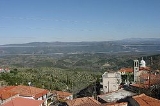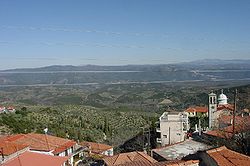
Longanikos
Encyclopedia
Longanikos is a traditional Greek
village, located in Laconia
, in the ancient and historical Peloponnese area of southern Greece. It is also referred to sometimes in English as "Logganiko(s)" or "Longanico(s)". It is about 30 kilometers north of Sparta
, the capital city of Lakonia, and is also very close to the cities of Kalamata
, Tripolis and Megalopolis
. It rests on the northeastern slope of Mount Taigetos. The current population of Longanikos is about 702 inhabitants according to government population statistics. This figure may include the population of the surrounding smaller villages like Vergadeika, Kiparrissi, Foundeika, and Aghios Konstantinos. Because of the small size of this village, residents of this town often identify themselves as Spartans to other Greeks or foreigners. For those who are familiar with this area, a resident or person from Longanikos is referred to as a "Longanikiotes" (masc) or "Longanikiotissa" (fem).
 The village changed location and name many times since the earliest record of its existence in Mycenaean
The village changed location and name many times since the earliest record of its existence in Mycenaean
times. The area of Longanikos has been identified with the ancient village of Velamini (Velmini), documented in ancient writings by Pausanias over 1800 years ago. The current name has been documented in writings as far back as Stefano Magno in 1453. It is believed that this area has been inhabited since Neolithic
times, and much later served as a front-line military outpost for the powerful Spartan city-state.
As a result of its geographical position between the 3 prefectures of Messinia, Arcadia and Laconia and because of the morphology of the ground where Taigetos and Parnonas converge without connecting, thereby creating the Laconian valley of Eurotas, Logganikos has served as a key transit point for the movement of people and armies in the Peloponese. It had also served as a military staging area and rampart for the state of Sparta.
Today the village of Longanikos also includes the settlements of Vergadeika, Kiparissi, Giakoumeika and Foundeika. It is nestled along the green slopes and fir-covered mountain range of Mt. Taigetos and one can find stone houses, natural springs and fountains and forest roads that lead to the highest points of the mountain (Koutouni, Limna). Nearby one can also find some fountains that feed the Eurotas valley and the historical monasteries of Rekitsa and Ampelaki, close to the Arcadian border.
During the turn of the 20th century and also during the 1960s and 1970s, there was a huge outflow of residents to other major Greek cities, including Athens and Sparta, and also externally to the United States
, Canada
, Germany
, South Africa
, and Australia
.
A high concentration of emigrants who went to the USA settled in the suburbs of Boston MA, primarily the towns of Lynn and Lowell, Massachusetts in the 60's and onwards, which historically have been gateway cities in Massachusetts for various immigrant groups from all over the world. In the beginning of the 20th century, Ipswich was also a gateway city. One of the most famous people with ties to Longanikos was Harry Agganis
, also known as the "Golden Greek".
This global diaspora of Longanikos emigrants still maintain strong ties with the village and during summer months the population swells with diaspora residents who have returned for summer holidays. In addition to its central location between Sparta and Tripoli, it is also only a 2.5 hour drive from central Athens and within driving distance of many famous sites, including Olympia, Monemvasia, Caves of Dirrou, Githeo, Kalamata, Corinth, the Argolid (Epidavros, Nafplion), amongst others.
Greece
Greece , officially the Hellenic Republic , and historically Hellas or the Republic of Greece in English, is a country in southeastern Europe....
village, located in Laconia
Laconia
Laconia , also known as Lacedaemonia, is one of the regional units of Greece. It is part of the region of Peloponnese. It is situated in the southeastern part of the Peloponnese peninsula. Its administrative capital is Sparti...
, in the ancient and historical Peloponnese area of southern Greece. It is also referred to sometimes in English as "Logganiko(s)" or "Longanico(s)". It is about 30 kilometers north of Sparta
Sparta
Sparta or Lacedaemon, was a prominent city-state in ancient Greece, situated on the banks of the River Eurotas in Laconia, in south-eastern Peloponnese. It emerged as a political entity around the 10th century BC, when the invading Dorians subjugated the local, non-Dorian population. From c...
, the capital city of Lakonia, and is also very close to the cities of Kalamata
Kalamata
Kalamata is the second-largest city of the Peloponnese in southern Greece. The capital and chief port of the Messenia prefecture, it lies along the Nedon River at the head of the Messenian Gulf...
, Tripolis and Megalopolis
Megalopolis, Greece
Megalópoli is a town in the western part of the peripheral unit of Arcadia, southern Greece. It is located in the same site as ancient Megalopolis . "Megalopolis" is a Greek word for Great city. When it was founded, in 371 BC, it was the first urbanization in rustic and primitive Arcadia. In...
. It rests on the northeastern slope of Mount Taigetos. The current population of Longanikos is about 702 inhabitants according to government population statistics. This figure may include the population of the surrounding smaller villages like Vergadeika, Kiparrissi, Foundeika, and Aghios Konstantinos. Because of the small size of this village, residents of this town often identify themselves as Spartans to other Greeks or foreigners. For those who are familiar with this area, a resident or person from Longanikos is referred to as a "Longanikiotes" (masc) or "Longanikiotissa" (fem).
Administration
The village is administered as part of the Pellana region of the Laconia (aka Lakonia) prefecture. The Pellana region's administrative central office is located in the village of Kastania (aka "Kastorion", "Kastori") which is about 15 miles south of Longanikos. [Note: Diaspora Greeks looking for documents related to any legal, property, or citizenship issues for themselves or their family should look here first for information and guidance. However, in 2011 some of the administrative functions, formerly processed in the Kastori prefectural office, were migrated to municipal offices in Sparta. One should inquire as to the exact location for the services you are trying to obtain]History

Mycenaean Greece
Mycenaean Greece was a cultural period of Bronze Age Greece taking its name from the archaeological site of Mycenae in northeastern Argolis, in the Peloponnese of southern Greece. Athens, Pylos, Thebes, and Tiryns are also important Mycenaean sites...
times. The area of Longanikos has been identified with the ancient village of Velamini (Velmini), documented in ancient writings by Pausanias over 1800 years ago. The current name has been documented in writings as far back as Stefano Magno in 1453. It is believed that this area has been inhabited since Neolithic
Neolithic
The Neolithic Age, Era, or Period, or New Stone Age, was a period in the development of human technology, beginning about 9500 BC in some parts of the Middle East, and later in other parts of the world. It is traditionally considered as the last part of the Stone Age...
times, and much later served as a front-line military outpost for the powerful Spartan city-state.
As a result of its geographical position between the 3 prefectures of Messinia, Arcadia and Laconia and because of the morphology of the ground where Taigetos and Parnonas converge without connecting, thereby creating the Laconian valley of Eurotas, Logganikos has served as a key transit point for the movement of people and armies in the Peloponese. It had also served as a military staging area and rampart for the state of Sparta.
Today the village of Longanikos also includes the settlements of Vergadeika, Kiparissi, Giakoumeika and Foundeika. It is nestled along the green slopes and fir-covered mountain range of Mt. Taigetos and one can find stone houses, natural springs and fountains and forest roads that lead to the highest points of the mountain (Koutouni, Limna). Nearby one can also find some fountains that feed the Eurotas valley and the historical monasteries of Rekitsa and Ampelaki, close to the Arcadian border.
Economy
Most of industry in this area centers around olive cultivation, resulting in the production of olive oil as the main cash crop. The extra virgin olive oil that is produced is of the highest standards and quality and is sought out by olive oil importers globally.During the turn of the 20th century and also during the 1960s and 1970s, there was a huge outflow of residents to other major Greek cities, including Athens and Sparta, and also externally to the United States
United States
The United States of America is a federal constitutional republic comprising fifty states and a federal district...
, Canada
Canada
Canada is a North American country consisting of ten provinces and three territories. Located in the northern part of the continent, it extends from the Atlantic Ocean in the east to the Pacific Ocean in the west, and northward into the Arctic Ocean...
, Germany
Germany
Germany , officially the Federal Republic of Germany , is a federal parliamentary republic in Europe. The country consists of 16 states while the capital and largest city is Berlin. Germany covers an area of 357,021 km2 and has a largely temperate seasonal climate...
, South Africa
South Africa
The Republic of South Africa is a country in southern Africa. Located at the southern tip of Africa, it is divided into nine provinces, with of coastline on the Atlantic and Indian oceans...
, and Australia
Australia
Australia , officially the Commonwealth of Australia, is a country in the Southern Hemisphere comprising the mainland of the Australian continent, the island of Tasmania, and numerous smaller islands in the Indian and Pacific Oceans. It is the world's sixth-largest country by total area...
.
A high concentration of emigrants who went to the USA settled in the suburbs of Boston MA, primarily the towns of Lynn and Lowell, Massachusetts in the 60's and onwards, which historically have been gateway cities in Massachusetts for various immigrant groups from all over the world. In the beginning of the 20th century, Ipswich was also a gateway city. One of the most famous people with ties to Longanikos was Harry Agganis
Harry Agganis
Aristotle George Agganis ' , nicknamed "The Golden Greek", was an American athletic star in two sports. His family origins were from Longanikos near Sparta, Greece. -Career:...
, also known as the "Golden Greek".
This global diaspora of Longanikos emigrants still maintain strong ties with the village and during summer months the population swells with diaspora residents who have returned for summer holidays. In addition to its central location between Sparta and Tripoli, it is also only a 2.5 hour drive from central Athens and within driving distance of many famous sites, including Olympia, Monemvasia, Caves of Dirrou, Githeo, Kalamata, Corinth, the Argolid (Epidavros, Nafplion), amongst others.

